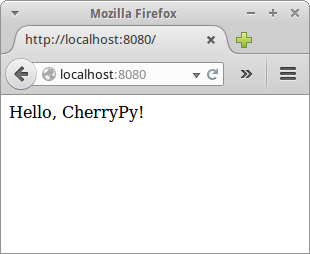CSC/ECE 517 Fall 2014/ch1a 3 zq: Difference between revisions
m (→Features: some more basic features) |
(→Features: 2 more features (multiple http server, functional test)) |
||
| Line 42: | Line 42: | ||
=== Publish REST APIs === | === Publish REST APIs === | ||
=== Multiple HTTP Servers === | |||
=== Writing Functional Tests === | |||
== References == | == References == | ||
<references/> | <references/> | ||
Revision as of 21:55, 13 September 2014
CherryPy Framework
CherryPy is a python based, object-oriented web framework that enables developers to quickly create lightweight and fast web applications.<ref>http://www.cherrypy.org/</ref><ref>http://en.wikipedia.org/wiki/CherryPy</ref>
Some of the popular websites using it are Hulu<ref>http://tech.hulu.com/blog/2013/03/13/python-and-hulu/</ref> and Netflix<ref>http://techblog.netflix.com/2013/03/python-at-netflix.html</ref>. The full list of applications using it can be found here.<ref>http://docs.cherrypy.org/en/latest/intro.html#websites-running-atop-cherrypy</ref>
Background
Basic Example
The following code demonstrates the most basic webserver using the CherryPy framework.
import cherrypy
class WebApp(object):
@cherrypy.expose
def index(self):
return "Hello, CherryPy!"
cherrypy.quickstart(WebApp())
Run the application, and open your web browser to localhost:8080. The following page is displayed
Features
Logging
Query Strings
Cookies
Sessions
Serve Static Content
Ajax Support
Publish REST APIs
Multiple HTTP Servers
Writing Functional Tests
References
<references/>
